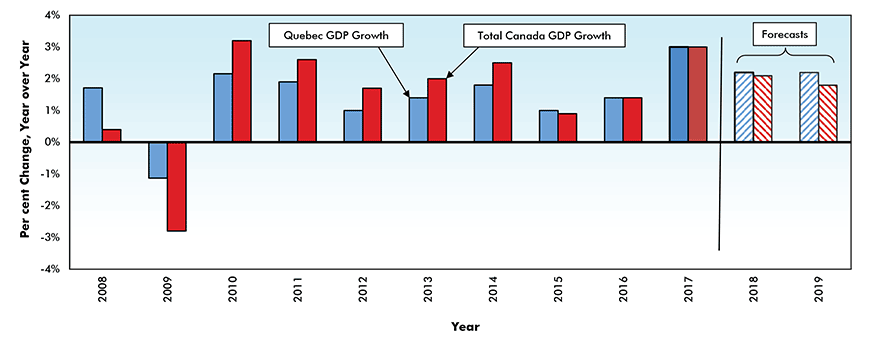Midway through the first half of 2018, the key indicators of Quebec’s economic health collectively suggest that La Belle Province is in very good shape.
This being said, there is evidence that after posting an estimated gain of 3% in 2017, its strongest showing since 2000, the Quebec economy will grow at a more sustainable rate in the range of 2.0% to 2.5% through the remainder of 2018 and well into 2019.
High on the list of indicators reflecting the current positive state of the Quebec economy is the province’s labour market. Although the pace of hiring has cooled slightly since mid 2017, total employment is up by 85K over the past twelve months.
Taking a closer look at the composition of the solid increase in headline employment, over the past year full-time hiring in the province is up by 150K, more than offsetting a 65k drop in part-time employment.
Also, according to the most recent Statistics Canada job vacancy report, the total number of job vacancies in the province has increased by 46% over the past twelve months, twice the increase exhibited by the country as a whole. This jump took the job vacancy rate to a three-year high of 2.6% in the final quarter of 2017.
Given the very strong growth of full-time hiring over the past twelve months, it is not surprising that, based on the results of its most recent (March) Survey of Consumer Confidence, the Conference Board in Canada reported that “Quebecers remain the most confident in the country”.
Against this background of burgeoning consumer confidence, solid growth of average weekly earnings and persisting low interest rates, consumer spending and housing demand have contributed to very robust growth of domestic demand throughout 2017 and into 2018.
Indeed, despite the impact of the Office of the Superintendent of Financial Institution’s more stringent mortgage stress test, Quebec was the only province to see a year-over-year increase in March home sales.
Despite the strong pattern of existing home sales, single-family starts have exhibited little change over the past year. However, fuelled by the combination of record net in-migration, the above-noted growth of full-time employment and a sharp drop in apartment vacancy rates, starts of multiple units are up by a very strong 37.8% year to date.
Further, given the positive outlook for employment indicated by the higher job vacancy rate and the fact that applications to build multiple units are up by 17% y/y in February, the outlook for residential construction in the province remains quite bright during the remainder of this year and into 2019.
The outlook for capital spending in Quebec in 2018 is definitely brighter than it was in 2017. Consistent with the very high level of optimism among Quebec’s entrepreneurs, the Business Development Bank of Canada’s (BDC) Investment Intentions Survey revealed that the province’s small- and medium-sized businesses are planning to boost their investment spending by 11% this year, well ahead of the 0.5% increase they planned during 2017.
This improved investment outlook is very much in line with the more comprehensive Statistics Canada Survey of Non-residential Capital and Repair Expenditures (CAPEX) report. According to Statistics Canada, after contracting by an estimated 2% in 2017, Quebec firms are planning to increase their investment spending by 5.4% in 2018, a five-year high.
At the same time, Statistics Canada reported that Quebec’s public sector capital spending is projected to increase by 4.9% this year after posting a gain of 8.7% in 2017. It is also worth noting that the Statistics Canada CAPEX survey was undertaken ahead of the Quebec Budget released on March 28.
While much of the money committed in the budget will be spent in the medium term, the government, facing a fall election and flush with a 4.2% increase in revenues in fiscal 2017-18, added $9.3 billion to the Quebec Infrastructure Plan.
According to the Budget, the government now plans to invest $100.9 billion on public infrastructure over the next ten years, mostly on roads (19.9%), health and social services (18.6%) and education (16.1%). The plan includes funding for the Réseau express métropolitain/REM ($6.3 billion), Quebec City’s $3 billion transit network and an extension to Montreal’s Blue Line subway route.
Real* Gross Domestic Product (GDP) Growth — Quebec vs Canada

Chart: ConstructConnect — CanaData.











Recent Comments